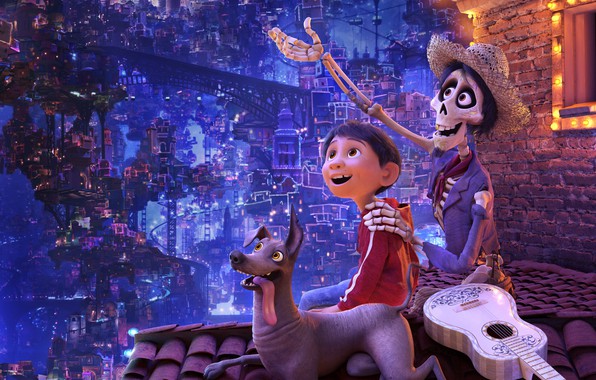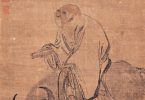“Coco” holds true to values, traditions and background
By: Daniel Otero
“Coco” represents the current issues on what’s happening between the U.S. and Mexico. Reflecting on how these two nations are intertwined historically and socially. With an all Hispanic/Latino cast, highest investment and tripling in its earnings; it clearly and continues to show how much the U.S. still needs its immigrant community to succeed.
Some cartoons can teach a deeper meaning to life. This is one example from PIXAR.
Let’s begin explaining what is Day of the Dead. It’s a national day in Mexico to remember those who have past away, people build altars and give offerings with the decease’s favorite treats (usually memorialized between 31 October to 2 November); which for many countries around the world celebrate it in different forms. In China it’s called, Qingming (Tomb Sweeping Day) and in the U.S., U.K. or Ireland, it’s All Soul’s Day.
But one thing holds true, it’s to remember the dead.
In the case of Miguel (Anthony Gonzalez), the Day of the Dead is about to begin… But he wants to play in the music festival. His family wants him to uphold family traditions and become a shoemaker and not a mariachi. This little boy’s family denies music, because of a sad-cruel past. When Coco’s (Miguel’s great-grandmother) father ‘abandoned’ the family.
Here is where Miguel has an argument with his grandmother and family and runs away to the cemetery.
He’s purpose is to ‘borrow’ the guitar from Ernesto de la Cruz (Benjamin Bratt), a famous singer in life, now deceased.
Something strange occurs when he grabs the guitar. He suddenly crosses over. And he’s transported into the land of the dead.
There, he’ll meet his deceased-family members.
But there’s a problem, Miguel must cross back into the land of the living before sunrise or he’ll remain with his deceased-family members forever.
Here’s when Miguel embarks on his adventure. Before he goes back, he wants to meet his great-great grandfather, who he thinks is Ernesto de la Cruz. To get his blessing and become a musician.
Miguel will meet up with a swashbuckling-trickster, Hector (Gabriel Garcia-Bernal), who tells the boy he knows Ernesto and can help him.
However, Hector has problems of his own. He needs to get his photograph to the land of the living or he won’t be able to cross once a year. Therefore, if he cannot cross, he’ll be forgotten by his family members and his spirit will disappear forever.
Miguel agrees to help out Hector and take his photograph back once their mission is completed.
Miguel and Hector team-up to get into Ernesto’s mansion. However, when they finally find the famous musician who is much more famous in the land of the dead than the living, they also discover that Ernesto is a fraud. He stole all the songs from Hector in life and murdered him–when his friend was trying to go back home. Yes, Hector never abandoned his family. Furthermore, turns out, Ernesto isn’t Miguel’s great-great grandfather, but it’s Hector himself.
At the music festival in the land of the dead, they must fight Ernesto. That’s when Hector reunites with his estranged-dead family and they find out the truth of his murder and murderer.
Ernesto tries to hurt and destroy little Miguel, but he’s caught on television cameras trying to do so. Here’s when he’ll be dishonored and forgotten for his evil deeds in both worlds, the land of the living and the dead.
Miguel is transported back to the land of the living just in the ‘nick of time’. But he goes back without Hector’s photo.
Back home, when Miguel’s searching among Coco’s things, he finds Hector’s notebook and a piece of his torn photograph. By placing this torn photo together, Hector will be remembered and can cross once a year into the land of the living.
Miguel is able to chase after his dream and become a professional musician.
What can this film teach us?
It can teach children about life and death, and the normalcy of this, without denying the facts. It teaches about the importance of family and upholding traditions; therefore, never forgetting customs. Something which societies are often too keen on doing today in their pursuit of modernity. There’s a lesson for all, to never lose hope or give up in life. That not everything is lost if memories and love remain.
I gave this motion picture four-stars out of five for its content, quality and deeper meaning.
“Coco” enseña valores, tradiciones y respeto a los ancestros
Por: Daniel Otero Maldonado
“Coco” representa las temáticas sociales y lo que ocurre en el presente entre los EE.UU. y Méjico. Reflejando que estas dos naciones están profundamente unidas por su historia y sociología.
Con un elenco total de hispanos/latinos, es la inversión más alta hecha en caricaturas y triplicó recientemente sus ganancias. Demostrando claramente como los EE.UU. necesita de su comunidad emigrante para avanzar de forma exitosa.
Algunas caricaturas demuestran y enseñan una profunda lección en la vida. Éste es un ejemplo de PIXAR.
Comencemos con la explicación, ¿qué es el Día de los muertos? Es un día nacional en Méjico; por el cual, la población conmemora a los familiares y seres queridos que han pasado de la existencia terrenal. Familiares construyen altares con fotos de sus amados muertos y colocan las mejores comidas que al difunto(a) le gustaba. Usualmente, los días para este recordatorio ocurren entre el 31 de octubre al 2 de noviembre. En muchos países alrededor del mundo hacen la conmemoración de distintas formas. En China le llaman, Qingming (Día para barrer la tumba) y en los EE.UU., Reino Unido o Irlanda, es el Día de los espíritus.
Pero una cosa es cierta, es para recordar a los muertos.
En el caso de Miguel (Anthony González), el Día de los muertos está por comenzar.
Y él quiere tocar en el festival musical.
Pero su familia desea que él respete las tradiciones, y se convierta en un zapatero, y
no en un mariachi.
La familia de este chico niega cualquier tipo de música, por un pasado triste y oscuro
que le ocurrió a su bisabuela. Cuando el papá de Coco (bisabuela de Miguel),
‘abandonó’ a su familia.
Y es cuando Miguel tiene una tremenda discusión con su abuela, y luego, se escapa para visitar el cementario.
Miguelito quiere tomar ‘prestado’ la guitarra del gran Ernesto de la Cruz (Benjamín Bratt); famoso cantante, quién muerió de forma inoportuna y trágica.
Cuando Miguel agarra la guitarra, algo extraño le ocurre. Automáticamente es transportado a la tierra de los muertos. Aquí se reúne con sus familiares ya fallecidos.
Y es cuando la situación se complica. Este chico tiene qué volver a cruzar a la tierra de los vivos antes que amanezca. Si no, se quedará en la tierra de los muertos para siempre.
Miguel decide embarcase en una aventura. Antes qué regrese a la tierra de los vivientes, éste desea conocer a su tatarabuelo para obtener su bendición y convertirse en un gran músico. Quién Miguel piensa que es, Ernesto de la Cruz.
Miguel se topa con un travieso-tramposo llamado, Héctor (Gabriel García-Bernal). Quién le dice qué conoce a Ernesto de la Cruz y le puede ayudar.
Pero, Héctor tiene mayores problemas. Éste necesita que su fotografía llegue a la tierra de los vivientes o no podrá cruzar el próximo año. Por tanto, si no puede cruzar, los miembros de su familia se olvidarán de éste y su espíritu desaparecerá para siempre.
Miguel accede a ayudar a Héctor y llevar su foto de regreso a la tierra de los vivientes, una vez el joven complete su misión.
Miguel y Héctor se unen para entrar a la mansión de Ernesto.
Pero, cuando finalmente encuentran al famoso músico-quién es más famoso en la tierra de los muertos que los vivos-también descubren que Ernesto es un fraude. Él se robó todas las canciones de Héctor en vida y luego lo asesinó–cuando su amigo intentaba regresar a su familia. Por tanto, Héctor nunca abandonó a su familia.
También resulta que Ernesto no es el tatarabuelo de Miguel; pero, lo es Héctor.
En el festival de la música en la tierra de los muertos, Miguel y Héctor tienen qué luchar contra Ernesto. Y es cuando Héctor se reúne nuevemante con los miembros de su familia fallecida, y estos descubren la verdad sobre la desaparación de Héctor en vida.
Ernesto intenta hacerle daño al pequeño Miguel; pero todas las cámaras televisivas cogen a este canalla intentando destruirlo. Y aquí es que Ernesto es deshonrado y será olvidado por todo el mal que ha hecho en ambos mundos.
Miguel es transportado justo a tiempo a la tierra de los vivientes. Pero, tristemente regresa sin la foto de Héctor.
Un día en su casa, Miguel busca entra las cosas de Coco, y encuentra por casualidad la libreta musical de Héctor y un pedazo de su foto rota. Al reparar la fotografía, es la imagen de Héctor y ahora éste podrá ser recordado y cruzar una vez al año a la tierra de los vivientes.
Miguel alcaza su sueño y se convierte en músico profesional.
¿Qué nos puede enseñar esta caricutura?
Puede enseñarles a los niños a compreder la naturalidad entre la vida y muerte. Sin negar la realidad. Enseña la importancia de familia, cultura y recordar las tradiciones. Algo que en nuestros tiempos contemporáneos las sociedades están dispuestas a olvidar sus tradiciones en búsqueda de la modernidad.
Hay una lección para todos. Nunca perder la esperanza en la vida. Y que no todo es olvidado, una vez queden los recuerdos y el amor.
En mi opinión, este largometraje merece cuatro estrellas de cinco: por su calidad, contenido y significado profundo.






